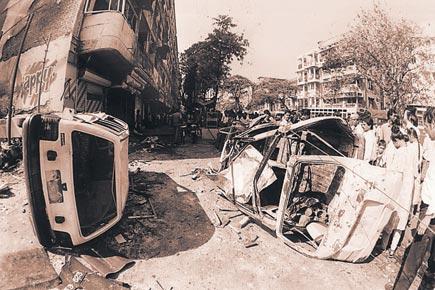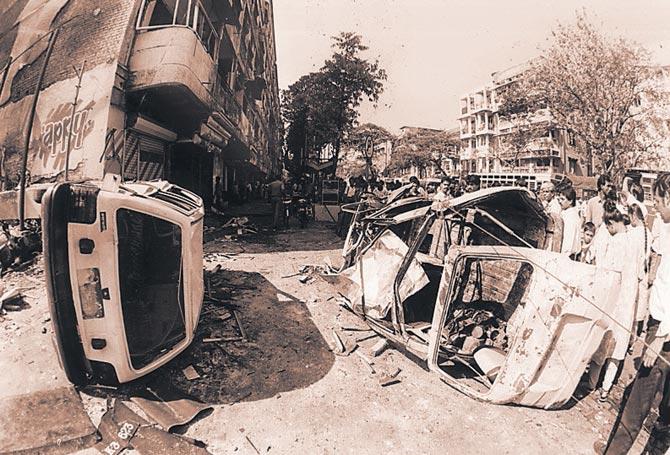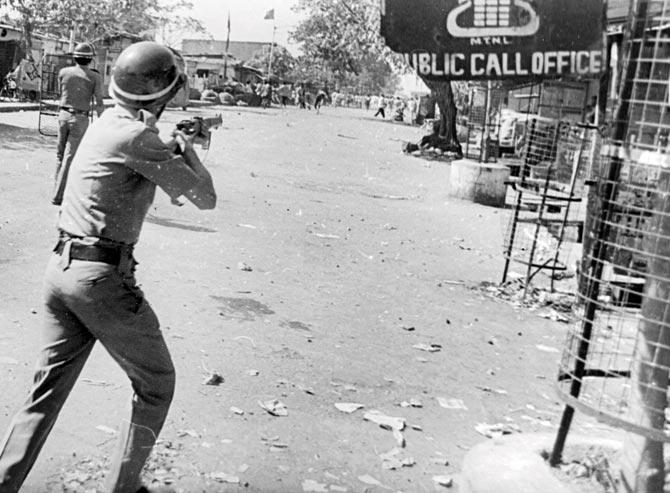Did the city change forever along with its name, or were there other reasons for how the Mumbai of today is so different from the Bombay of the 1990s? Find out...


Cars damaged in the blast at the Bombay Stock Exchange on March 12, 1993. The blasts and the riots that preceded them underlined a phase in the city's history, and coincided with the change of its name to Mumbai
ADVERTISEMENT
 I simply love Bombay. But I also admit to having a fondness for 'Mumbai', although this liking cannot be categorised as deep affection. Many readers may find this a contradiction since both names refer to the very same city. Why is it then that I miss and long for Bombay although much the same cannot be said of Mumbai?
I simply love Bombay. But I also admit to having a fondness for 'Mumbai', although this liking cannot be categorised as deep affection. Many readers may find this a contradiction since both names refer to the very same city. Why is it then that I miss and long for Bombay although much the same cannot be said of Mumbai?
Perhaps it's all in the mind which believes the two represent different dimensions of the same city. Permit me to explain:
When I look through a soft bifocal and remember a city where living was simple and working was fun, where despite the madness of the material world there were enough people who transcended crass commercialism and extended genuine warmth, where politics was not in your face and you didn't need big bucks in your pocket to have a good time — then Bombay is what immediately comes to mind.

A policeman takes aim at a group of protesters in Ramabai Nagar, Ghatkopar, in 1997. Ten people were killed when a team of State Reserve Police personnel opened fire on residents who were protesting the desecration of an Ambedkar statue. It was also the time religious and regional identities became important in a city that afforded anonymity. File photo
Mumbai, on the other hand, is very much part of the brash, new and chaotic millennium that we live in. The cars have become bigger, the roads broader, the buildings taller, the shopping arcades swankier, the restaurants and clubs more happening and expensive and the politics shriller, increasingly communal, parochial and sometimes violent.
People too have changed, mirroring the pressures of survival in a fast-paced city where you can no longer sit back and watch the world go by. Mumbai is a lot less casual than the city I once knew. Many more Mumbaikars have joined the ranks of the intolerant and judge you by your religion or the region you come from. Over the years, they have become suspicious and xenophobic.
Also, there is this sense of anxiety that you see writ large on the faces of citizens. Busy people have become busier with lesser time for niceties.
Last August, I happened to be in the city for my book launch. Among the first things I did was to call a friend and ask him if we could meet. He said he would have to see if he can tie up a few things to do in South Mumbai before venturing to our old favourite watering spot in Colaba for lunch. "I have no time and coming all the way from Borivli just for lunch would be such a waste of time," he said. His 'killing several birds with one stone' attitude was no doubt pragmatic but it was not in keeping with the old ethos where meeting friends was not reduced to a chore or fitting the rendezvous into a schedule.
I am not suggesting that all Mumbaikars are like my friend. He merely reflects an attitude in a world where our busy lives have reduced relationships to keeping in touch over mobiles even though we happen to be in the same city.
Very clearly, things have changed although it is hard to put a finger on what has exactly altered. Of course, you can get away by saying that the good old days are over when the sky was blue and life was easier — that generalisation, incidentally, applies to any city anywhere in the world where pollution, rising population and inflation have taken their toll.
But if you press me to be specific then I would venture to say that something we often refer to as the 'free spirit of Bombay', captured vividly in the stories of Sadaat Hasan Manto and Raj Kapoor movies, has either evaporated or been redistilled.
That is perhaps why, whenever work brings me to the city I say I am in Mumbai. But when I am on a holiday, catching up with old buddies and places, I always declare that I am in Bombay. It is another world etched in my subconscious.
That brings me to the question: Has the city changed just because it got itself a new name? Or did Bombay happen to become Mumbai at a time when the metropolis was undergoing a tectonic socio-political and economic transformation? I think the latter is closer to the truth.
Remember, the name-change came into effect in 1995 when the Shiv Sena first came to power in Maharashtra. One of the first things it did after assuming office was to assert Marathi identity by jettisoning the legacy of "Bombay" left behind by the British and restore the city to its original name, Mumbai.
There was no pressing demand for the change. In fact, if a poll was conducted at that time I am sure a sizeable number would have voted for retaining the old familiar name. However, once the official stamp was given to Mumbai, people quietly accepted and learned to live with it.
So, why does this Bombay vs Mumbai question prop up so often? It does so simply because the change of name also underlines a cataclysmic phase in the city's history — the 1993 riots and the bomb blasts that followed two months later on March 12.
Bombay was lost after these two events. In the shock wave that followed, the free city of culture and commerce turned increasingly communal. Communities became suspicious of each other. Hatred, fear, insecurity and intolerance took over. Having lived through the riots and the blasts, I know what happened. Suddenly, religious and regional identities became important in a city that afforded anonymity. Till today, the after effects have not quite worn off.
But despite all that, I love to rush back to Mumbai. It simply is the most vibrant and happening city in the country. And when I compare it to Delhi where I live, then I realise that regardless of all its wart, things are a lot better on the west coast — women are safer, the people are more helpful, honest and less complicated.
Yes, I love Mumbai. But I love Bombay a lot more...
The writer is a senior journalist who worked out of Mumbai for over a decade and is author of Junkland Journeys, a novel set in the city. Author photo/Anil Shakya
 Subscribe today by clicking the link and stay updated with the latest news!" Click here!
Subscribe today by clicking the link and stay updated with the latest news!" Click here!








